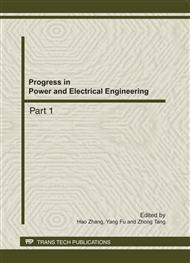[1]
Junping Deng, Xiaogang Wang, Xinwei Tian et al, Current status and development of thermal reduction process for magnesium smelting, China Nonferrous Metallurgy No. 5 (2006) 15-18.
Google Scholar
[2]
B.L. Mordike, P. Lukac, Creep behaviour of magnesium alloys produced by different techniques, International Magnesium Conference, 3rd, United Kingdom, (1997) 419-429.
Google Scholar
[3]
Jianping Peng, Shidong Chen, Xiaolei Wu et al, Study on thermal reduction of calcined dolomite by calcium carbide, Light Metals No. 3 (2009) 47-49.
Google Scholar
[4]
Guangwei Jiang, Zudi Zhang, Yupeng Shen, A clean and energy-saving production strategy for silicon-thermal reductive method in magnesium metallurgy industry, China Nonferrous Metallurgy No.3 (2005) 16-19.
Google Scholar
[5]
S. Ramakrishnan, N. Koltu, Global warming impact of the magnesium produced in China using the pidgeon process, Resour. Conserv. Recy. 42 (2004) 49-64.
DOI: 10.1016/j.resconrec.2004.02.003
Google Scholar
[6]
Dehong Xia, Tao Yu, Gang Zang et al, Diagnosis on energy consumption and energy-saving measures for pidgeons magnesium reduction process, Industry Furnace 27 (2005) 32-35.
Google Scholar
[7]
Zenggui Zhao, Problems and chances for China's magnesium industry, Conservation and Utilization of Mineral Resources No. 1 (1997) 35-37.
Google Scholar
[8]
Xianguo Lou, Youzhu Sun, Qingfu Hu, Preliminary exploration of the process conditions of calcination of magnesite, Jouranl of Hebei University of Science and Technology No. 1 (1988) 17-25.
Google Scholar
[9]
Guimin Lu, Dynamics of Calcined Magnesite, Light Metals No. 6 (1992) 36-39.
Google Scholar
[10]
Haiyan Qian, Min Deng, Shaoming Zhang, Experimental research on calcination of activated magnesia from magnesite, Non-Metallic Mines 27 (2004) 1-2.
Google Scholar
[11]
Xiaoli Tang, Changsheng Liu, Activity of dead-burned magnesia, Journal of East China University of Science and Technology 27 (2001) 157-160.
Google Scholar
[12]
Riyao Xu, The Technology of Refining Magnesium with Silicon Hot Method, Central South University Press, Changsha, 2003.
Google Scholar
[13]
Qingfu Guo, The experiment research of refining magnesium with aluminothermic process for magnesite, Light Medals No. 1 (1997) 40-42.
Google Scholar
[14]
Dehong Xia, Yingchun Shang, A new style magnesium reduction process deoxidizing by liquid calcium, Light Medals No. 2 (2008) 45-47.
Google Scholar
[15]
Mingxi Gui, Qingbin Xu, The mechanism of the thermal reaction of MgO and Al style, Foreign Refractories 31 (2006) 45-50.
Google Scholar
[16]
Hongxiang Liu, The experimental research and the equipment test of reduction magnesium by vacuum-aided carbothermal reduction, Dissertation of Kunming University of Science and Technology, Kunming, 2008.
Google Scholar
[17]
Zhihua Li, Researh on magnesia deoxidize by vacuum-aided carbothermal reduction, Dissertation of Kunming University of Science and Technology, Kunming, 2002.
Google Scholar
[18]
Yifu Li, Researh on refining magnesite by vacuum-aided carbothermal reduction, Dissertation of Kunming University of Science and Technology, Kunming, 2008.
Google Scholar
[19]
Jianping Peng, Shidong Chen, Study on thermal reduction of calcined dolomite by calcium carbide, Light Metals No. 3 (2009) 47-48.
Google Scholar
[20]
N. M. Bazhin, V. N. Parmon, Conversion of the chemical reaction energy into useful work in the Van't Hoff equilibrium box, J. Chem. Educ. 84 (2007) 1053-1055.
DOI: 10.1021/ed084p1053
Google Scholar
[21]
Ihsan Barin, Thermochemical Data of Pure Substance, Science Press, Beijing, 2003.
Google Scholar
[22]
Zhengwen Xu, Weiming Zhang, Bingcai Pan, Application of the polanyi potential theory to phthalates adsorption from aqueous solution with hyper-cross-linked polymer resins, J. Colloid Interface Sci. 318 (2008) 392-397.
DOI: 10.1016/j.jcis.2007.12.015
Google Scholar
[23]
O. Winkler, R. Bakish, Vacuum Matallurgy, Shanghai Science and Technology Press, Shanghai, 1982.
Google Scholar
[24]
Jianyong Cao, Zonghe Zhang, Dongxia Xiang, Magnesium motorcycle applicate, Mater. Sci. Forum 488-489 (2005) 915-918.
DOI: 10.4028/www.scientific.net/msf.488-489.915
Google Scholar


